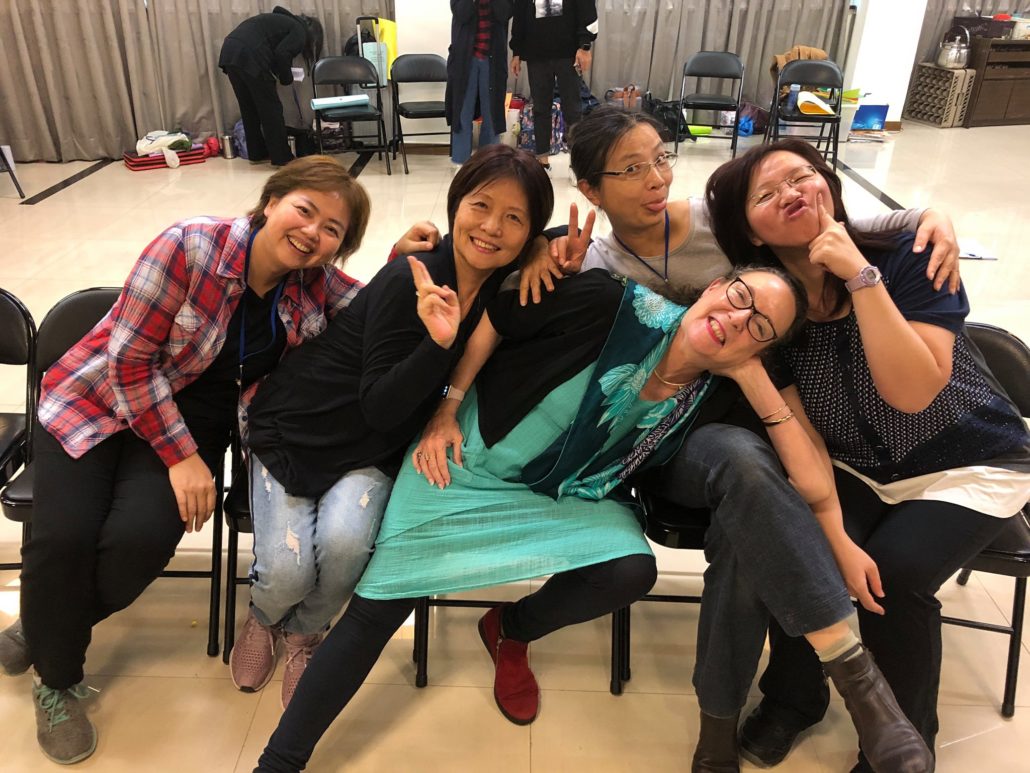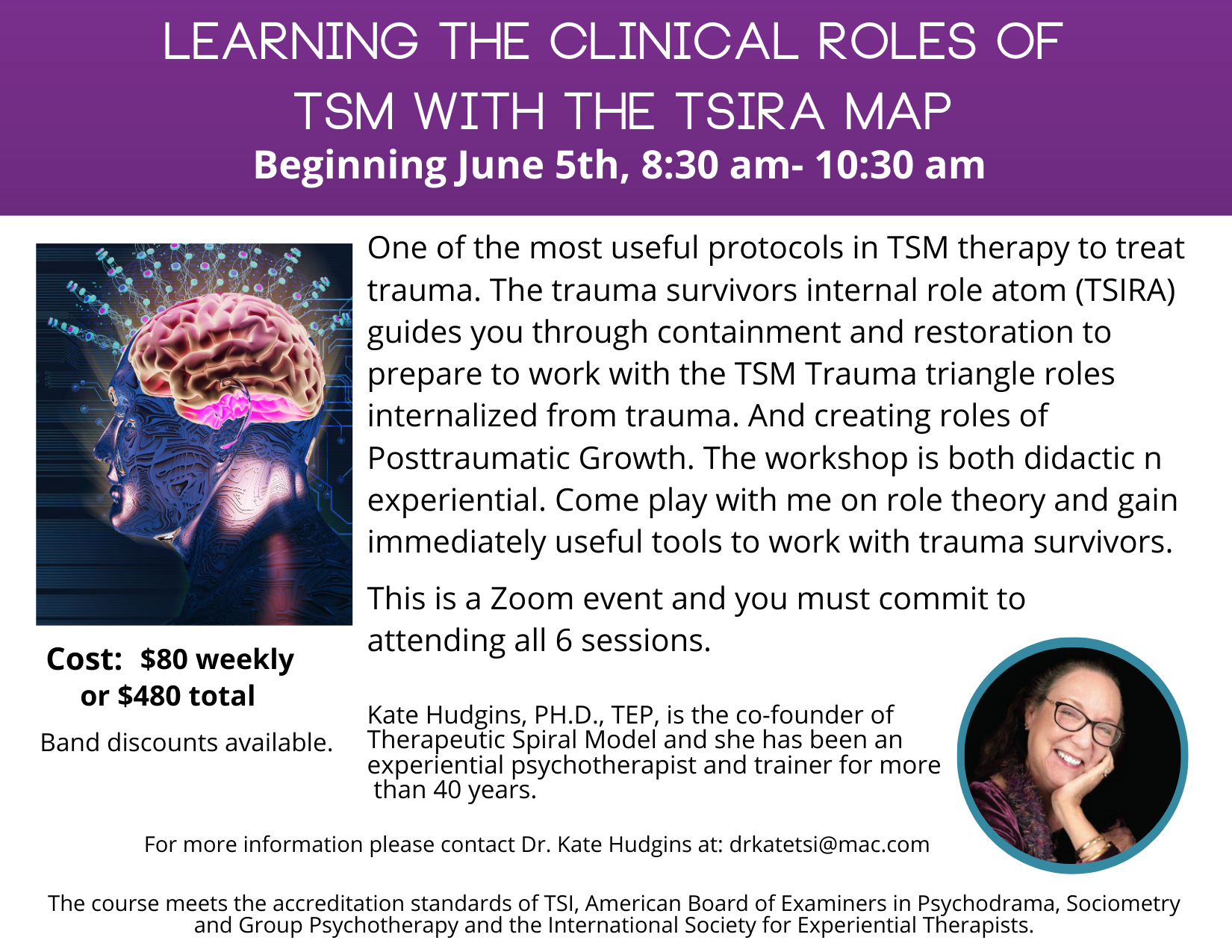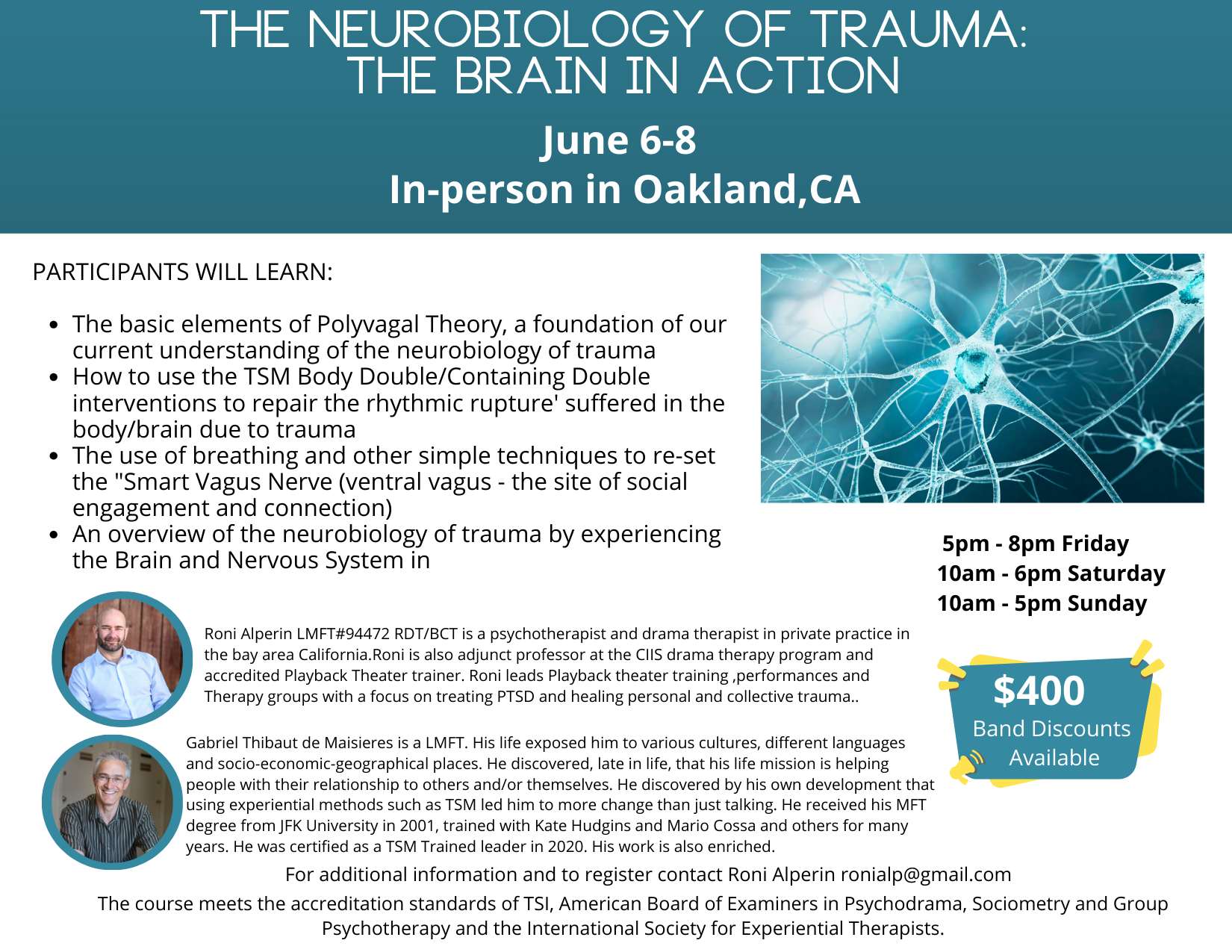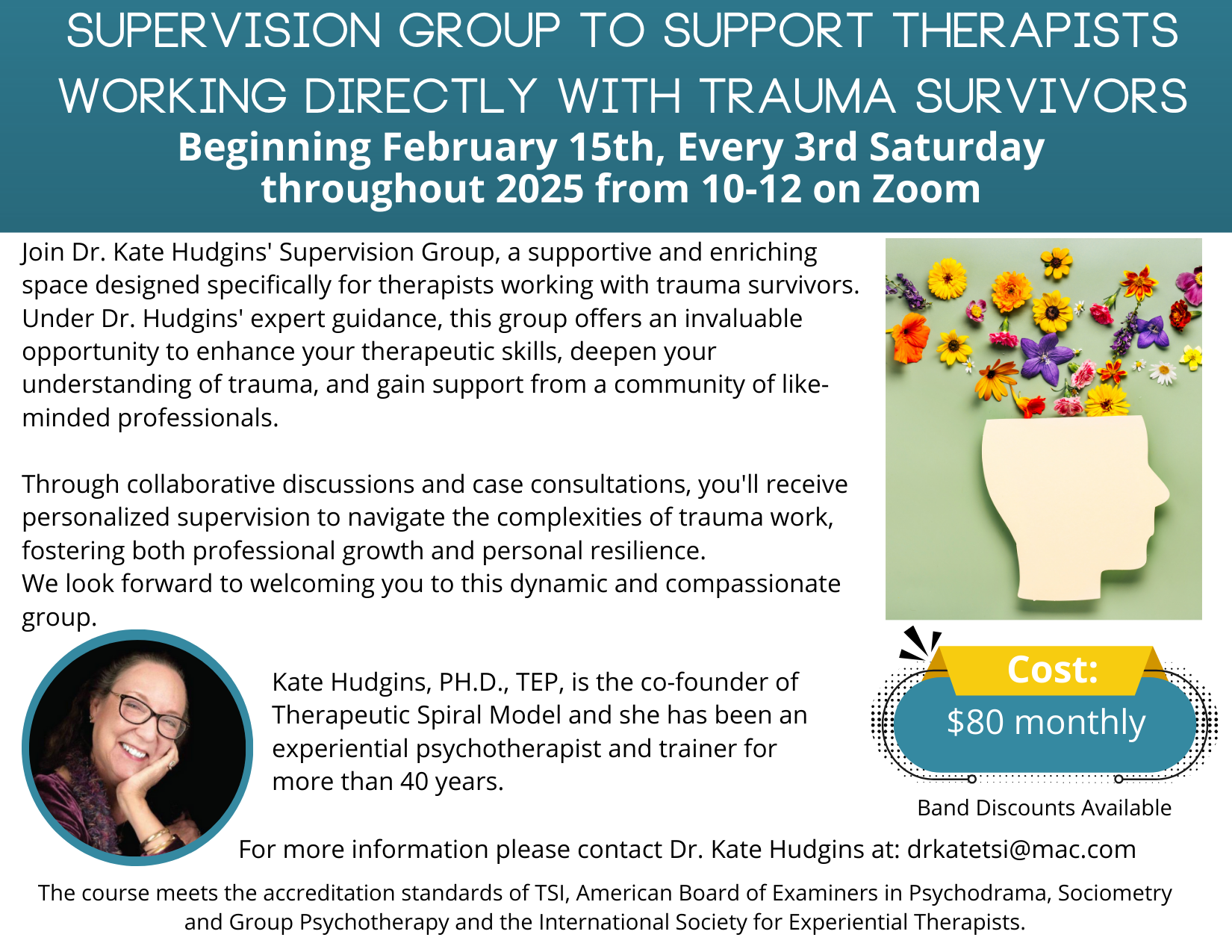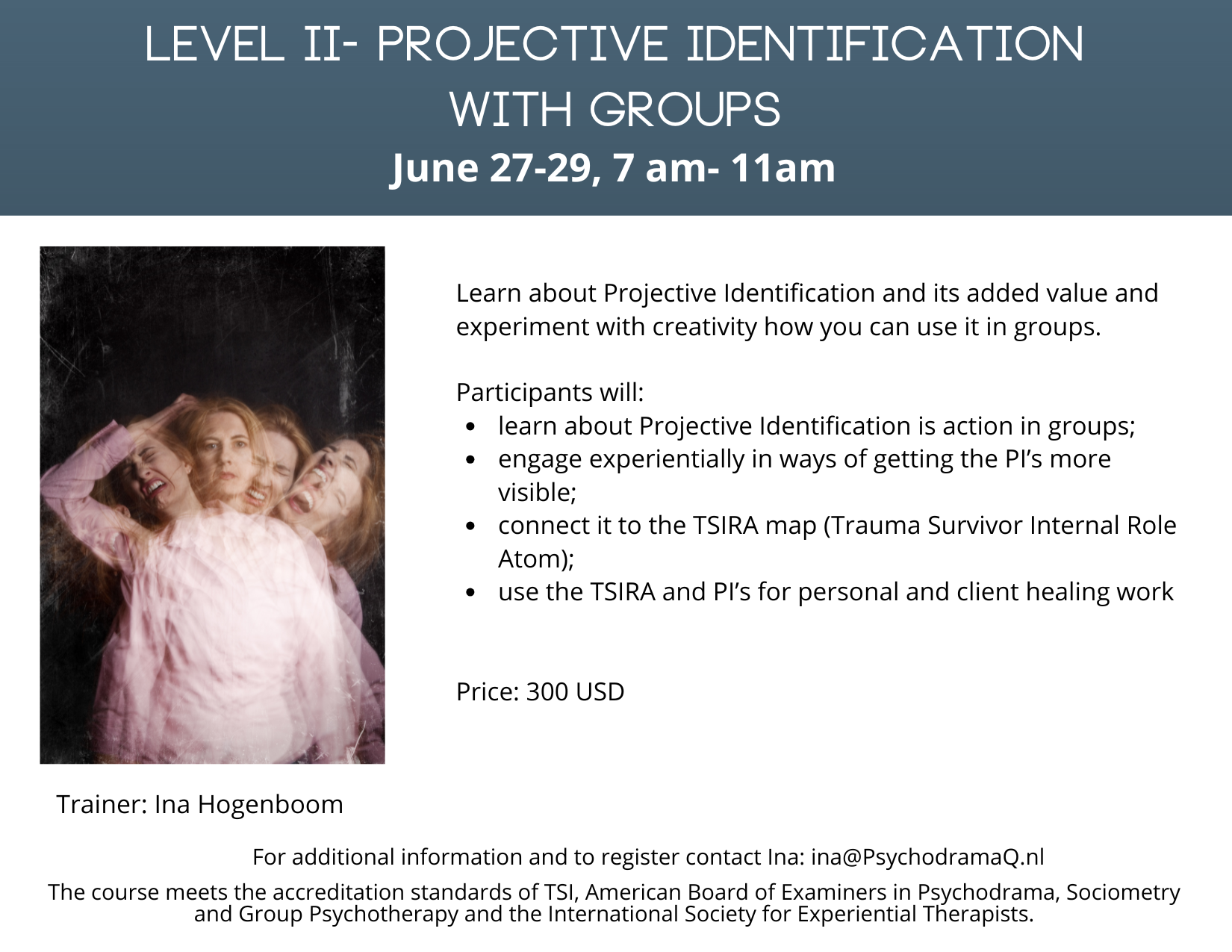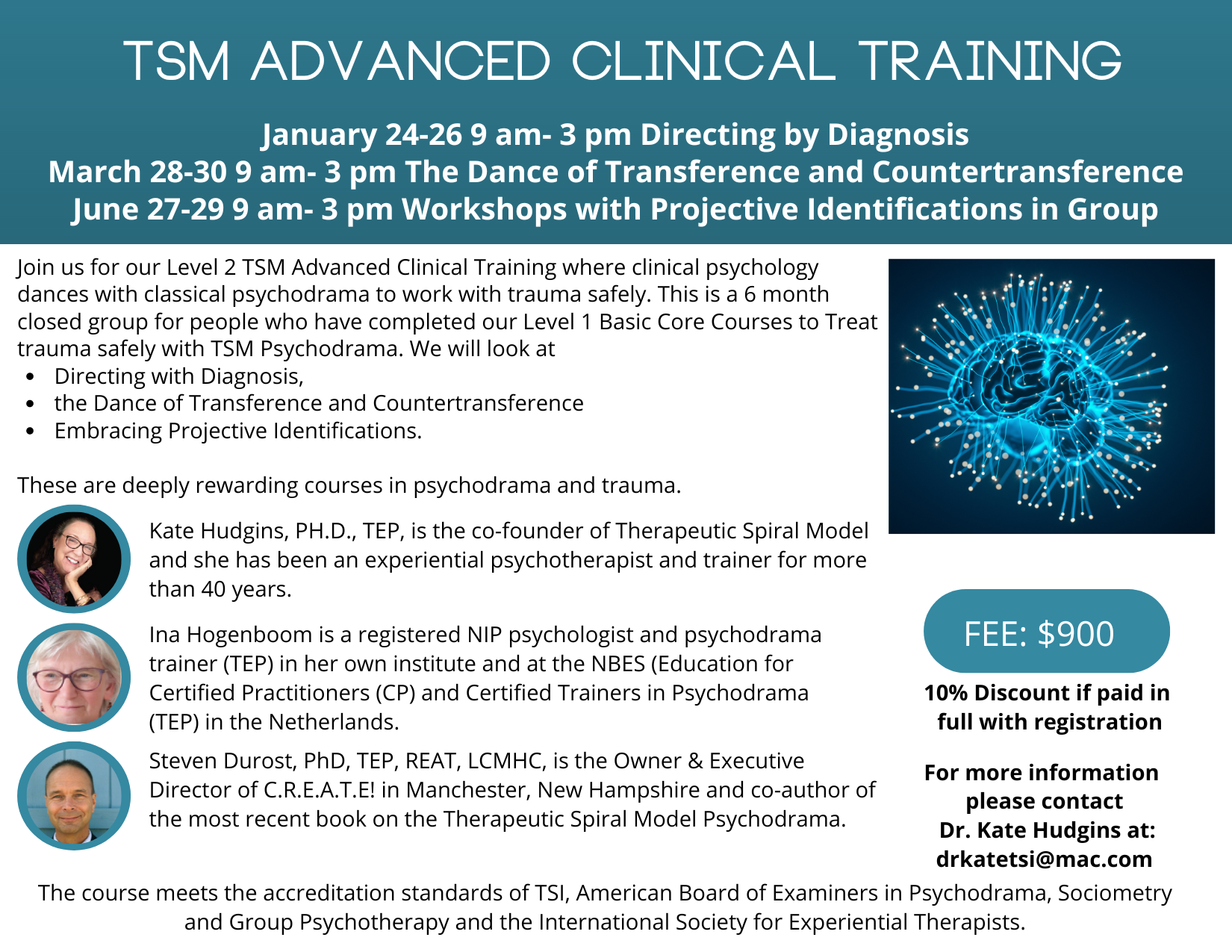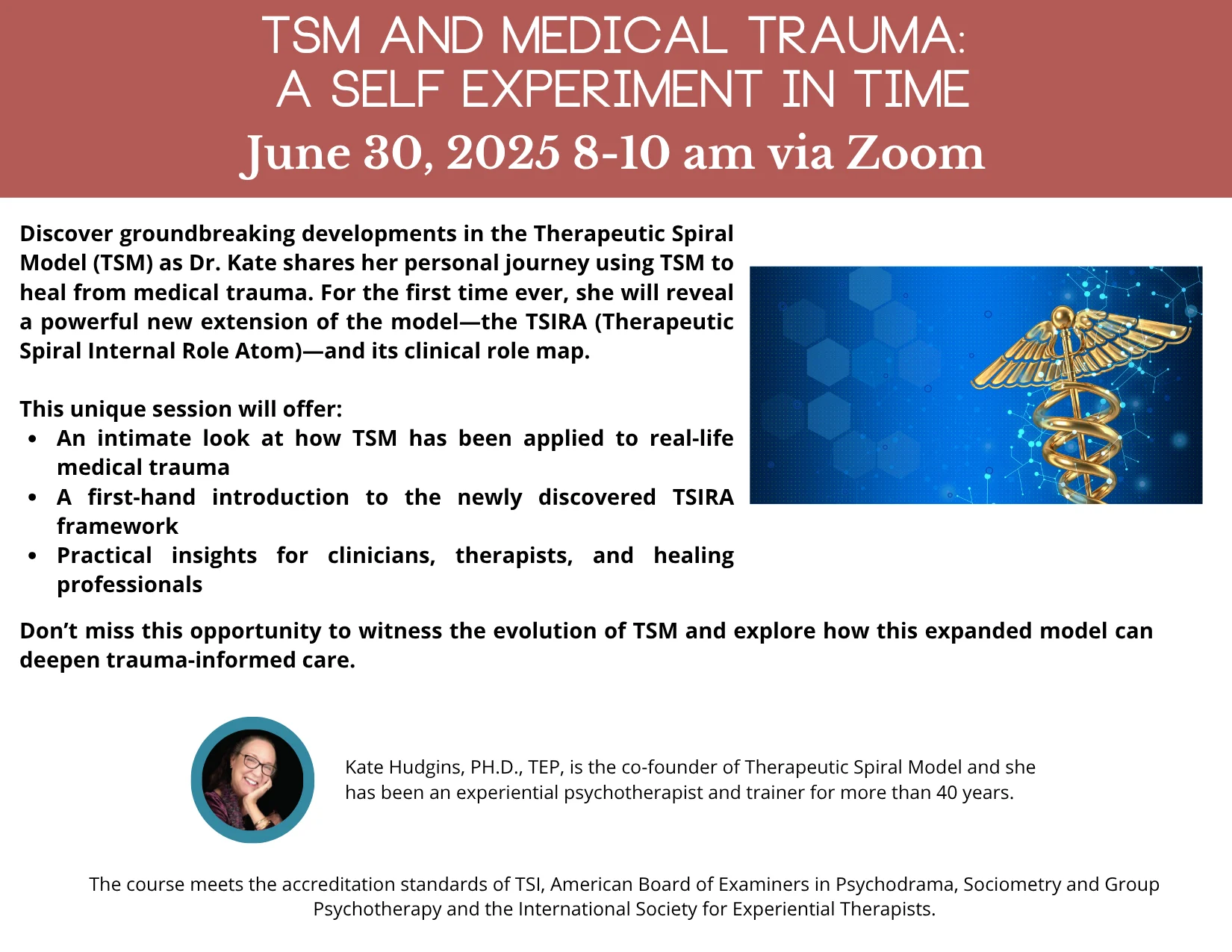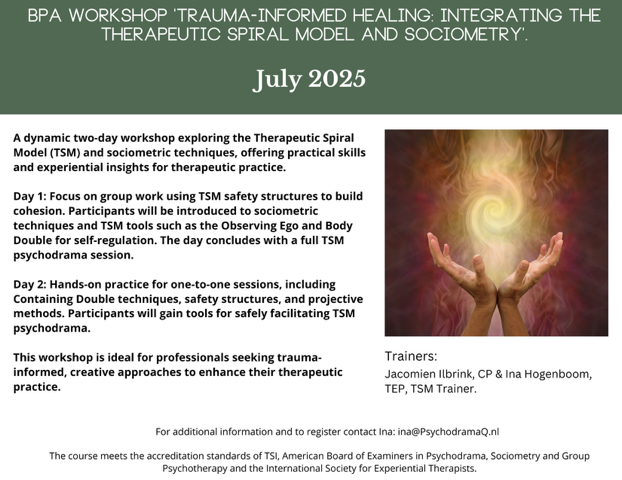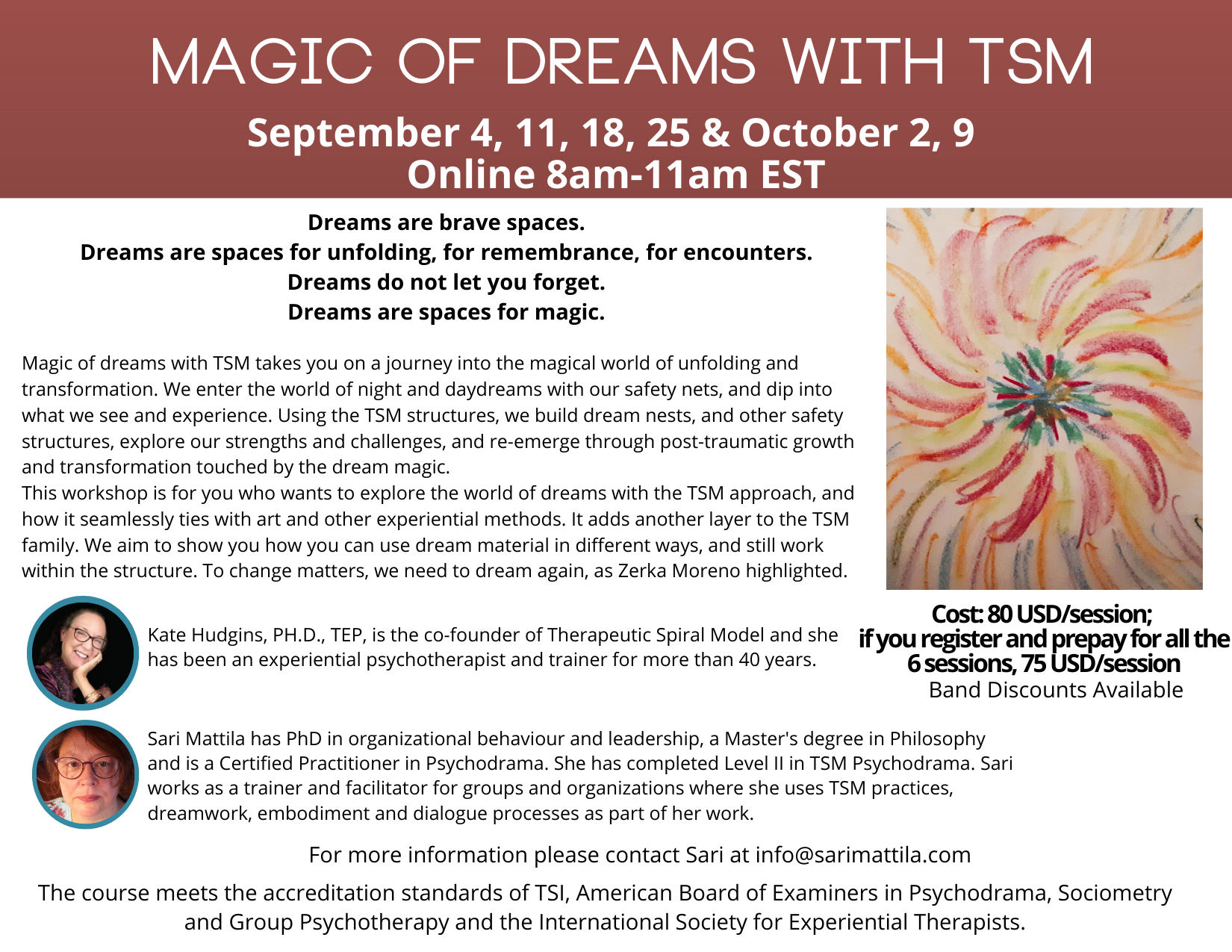TSI Certification Process
Requirements for TSI International Certification in Experiential Trauma Therapy– Level II: Advanced Theory and Practice
To complete this level of certification, students must also complete all requirements for the Level I Certification as described above. However, many of the Level II practice requirements may be met concurrently with meeting the Level I requirements. That is, a candidate does NOT have to complete the Level I Certification before beginning their Practicum.

Level II: Advanced Clinical Courses
- Differential Directing and Team Practice with Action Methods for Trauma
- The Dance of Transference, Countertransference, and Tele with Trauma Survivors
- Using Projective Identification with Groups
A detailed description with learning objectives for each course is provided at the end of this section of our website.
TSM Practicum: Each student designs and pursues their own practicum with supervision from the Clinical Director and Director of Training. Each level of certification (Trained Auxiliary Ego, Assistant Leader, and Team Leader) is met by the behavioral demonstration of specific skill sets (details and check lists may be downloaded at the end of this document). Please Note: In completing practicum requirements for AL and TL levels the candidate must be observed in role by at least two different Trainers and/or Team Leaders.
Professional practica can be established in any setting in which the person works, from individual therapy to social activism. The three levels of certification are sequential, and earlier levels must be met first. Candidates may elect to be certified in one, two, or all three levels. Requirements for meeting these team-role certifications can also be met by serving on teams for TSI-sponsored workshops and trainings. (Additional practicum requirements provided following the next section: Action Healing Teams.)
Action Healing Teams: Most TSI workshops have an Action Healing Team, which is comprised of a certified (or in process of certification) team leader (TL), an assistant leader (AL), and one or more trained auxiliary egos (TAEs). These teams are used in both training and personal growth workshops and provide an opportunity for people in training to receive live supervision and immediate feedback on their skills while working on certification in the various team roles. These teams are designed to provide the utmost in safety and containment even in the most intensely emotional TSM psychodramas.
The TL provides the overall leadership and direction for each workshop. They are responsible for directing the majority of TSM dramas and supporting all team members in their learning and personal processes. In this way, containment and safety are guaranteed for all participants.
The AL focusses primarily on the connections between the group members and the team, most importantly the director of the drama. Essentially, the AL is the double of the director, meaning that they tune in to the clinical intentions and action structures that the TL is implementing. To accomplish this, a primary duty is to communicate information from the TAEs to the TL so that every group member is included in the drama in the role of an Auxiliary or as an active witness, regardless of the size of the group.
TAEs enact all roles from the TSIRA that are needed throughout the workshop. In enacting each role, they strive for a clinical intervention that fits into the overall needs of group members. For example, during the prescriptive role scene they may be asked to provide the unique TSM roles of self-regulation (Body Double) and containment (Containing Double), as noted below. During the trauma scene, they prevent re-traumatization by taking the roles of victim, perpetrator, or abandoning authority.
Note: Psychodrama trainees who have been awarded TAE certification by Cathy Nugent in one of her Psychodrama Training groups are granted reciprocal TAE Status in the TSM Certification process.
Clinicians in training often use their team training to build their own local teams in inpatient settings, private practice, organizations, and community venues.
When candidate participate on teams at the various levels of training, the trainer or team leader fills out a check list to certify the behavioral demonstration of the specific skill sets required at that level of training. The candidate also completes a self-reflection form. These are submitted to the Clinical Director and to the Director of Training. For Certification at the AL and TL levels, candidates must be observed by at least two, TSM- Certified Trainers who have provided checklists for the work observed.
Practicum Requirements: To serve on a team for any of the Core Courses or topic-specific personal growth workshops, the candidate must first have taken the workshop as a participant (or had the requirement waived.) There are no set number of practica required for certification at each level but all required skills must have been met and documented. Fees for participation on teams are as follows:
- The first time a trainee serves as a team member at each level they must pay ½ the full fee for the workshop. They must also pay US $100 directly to the Trainer or Team Leader who provides their detailed checklist and written evaluation.
- For subsequent workshops, until certification for that level, the trainee pays US $200 directly to the Trainer or Team Leader and that fee includes the check-list/evaluation.
Supervision: The final part of TSI Practice Certification is on-going supervision. After submitting an initial application and resume, each person meets (in person or electronically) with the Clinical Director and/or the Director of Training to design their Individual Training Plan. They are also assigned a Primary Trainer/Supervisor who best suits their individual needs.
Each student who is in the certification program must meet monthly (in person or electronically) with their supervisor. This can be individual or group supervision. Individual supervision is an hour to an hour and a half. Group supervision is 2-3 hours. Live supervised practice is included when you participate on TSI Action Healing Teams. This supervision may be counted in lieu of the scheduled monthly supervision if desired.
Each student must also schedule a yearly Training-Plan-Review supervision with the Director of Training to make sure appropriate records and documentation is being maintained of the training process, and to have any adjustment to the Training Plan made. This supervision session may be in lieu of one of the regular, monthly, supervision sessions.
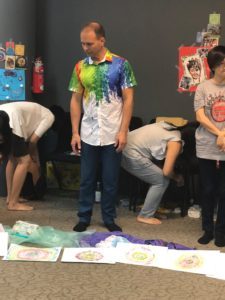
Level II Objectives – Participants will be able to:
- List the DSM-V criteria for diagnoses of mood, personality, dissociative, addictive and eating disorders.
- Demonstrate specific use of TSM clinical action interventions from the TSIRA, tailored to each diagnosis.
- Explain the TSM Action Healing Team roles, and describe their experiences with serving in one or more of the roles: TL, AL, TAE, or protagonist.
- List the signs of transference from clients or students, including positive, negative, and erotic transference.
- Explain how to regain the appropriate authority role to mirror for clients their transferences as good/bad mother or father, etc.
- Demonstrate the ‘asocial response’, interrupting the cycle of projecting the past into current relationships.
- Explain how to work with transference and countertransference in individual therapy and in small groups, as well as in full dramas.
- Describe their own strategies for maintaining stable personal boundaries that protect the practitioner from being triggered into personal issues.
- Define Moreno’s term “tele” and describe how it differs from transference and countertransference.
- Describe the clinical concept of projective identification.
- Accurately label experienced feelings that are projected from others.
- Use PIs in the service of others, helping them label unconscious feelings and observe their projection onto others.
- Participate in the processing of dramas from the viewpoint of the use of PIs.
- Describe how they will apply learning from this certification level in their professional setting(s).
Level II – TSI Advanced Clinical Courses:
Level II courses teach participants more advanced clinical theory related to using TSM Psychodrama to treat trauma and promote post-traumatic growth. In addition, more advanced observation and intervention skills in experiential action are explored for work in many settings. These clinical skills are not taught in any other psychodrama training program in the world. The courses provide deep, hands-on psychological learning about the psychodramatic process and nuances of personal and group psychology. Additionally, they afford exceptional personal growth opportunities.
As in Level 1, participants can receive practice supervision, generally on a once-monthly schedule, while working in their own professional setting, and/or by participating in TSM dramas as team members, and in the processing of these dramas. Protagonist opportunities and personal growth are included in all the workshops.The clinical skills developed are useful in diverse settings, including educational, therapeutic, and organizational.
Workshop 5 – Differential Directing and Team Practicewith Action Methods for Trauma
In this workshop the group will review and bring to life DSM-V (APA, 2013) diagnoses of mood, personality, dissociative, addictive, and eating disorders. The focal point of this workshop is on learning which of the TSM clinical action interventions are best suited to promote change with various diagnoses.
This Level 2 workshop also explores the Team Roles in depth and how to work both with and without a team using the clinical principles and structures of TSM. Participants take the roles of team leader, assistant, auxiliary, and protagonist experiencing their own healing, both personally and professionally, along the way. This workshop models and teaches how to work as an open, honest, and transparent team.
Note: From time to time we also offer a Level 2 training on Attachment and Trauma. This workshop can be used in lieu of the Differential Directing workshop to meet this requirement.
Objectives – Participants will be able to:
- List the DSM-V criteria for diagnoses of mood, personality, dissociative, addictive and eating disorders.
- Demonstrate specific use of TSM clinical action interventions from the TSIRA, tailored to each diagnosis.
- Explain the TSM Action Healing Team roles, and describe their experiences with serving in one or more of the roles: TL, AL, TAE, or protagonist.
- Describe how they will apply learning from this workshop in their professional setting(s).
Workshop 6 – The Dance of Transference, Countertransference, and Tele with Trauma Survivors
This workshop gives participants a deep personal and professional understanding of the way in which the dance of transference and countertransference can be interrupted when working with trauma survivors and instead genuine tele (Moreno’s term for the authentic, mutual unspoken connection between individuals) may emerge.
We focus on clinical depictions of transference and countertransference and how they can help or hurt the therapeutic process. When working with trauma survivors, the role of therapist, teacher, or leader of any sort sets the stage for a dance that has a few steps but can become quite intricate and inextricable, as the client transfers roles from the past onto the service provider. Therefore, it is important that the practitioner become skilled in labeling the transference without getting caught in it.
On the flip side of the coin, many practitioners find working with trauma survivors an intense and chaotic experience due to countertransference that gets triggered by stories of horror, terror, rage, grief, and despair.Clients’ survival defenses of dissociation, denial, minimization, over-identification with the aggressor, etc., may trigger reciprocal roles in the practitioner and they become pulled into the dance of transference and countertransference.
Participants will practice the ‘asocial response’ in action, which implements the TSM observing ego role by providing a neutral stance and accurate information to both client and therapist about transference and countertransference. Using Tele as the bridge to let go of old reciprocal roles, people learn to live in the here and now with authenticity and connection.
Objectives – Participants will be able to:
- Define Moreno’s term “tele” and describe how it differs from transference and countertransference.
- Describe how they will apply learning from this workshop in their professional setting(s).
- List the signs of transference from clients or students, including positive, negative, and erotic transference.
- Explain how to regain the appropriate authority role to mirror for clients their transferences as good/bad mother or father, etc.
- Demonstrate the ‘asocial response’, interrupting the cycle of projecting the past into current relationships.
- Explain how to work with transference and countertransference in individual therapy and in small groups, as well as in full dramas.
- Describe their own strategies for maintaining stable personal boundaries that protect the practitioner from being triggered into personal issues.
Workshop 7 – Using Projective Identification with Groups
This workshop uses action exercises to teach the difficult-to-understand clinical concept of projective identification (PI) during individual and group sessions. Projective identification is a normal psychological function for a baby, whereby the baby projects intense affect onto others in order to achieve accurate labeling and self-soothing. When these feelings are not accurately labeled due to trauma or attachment disruption, this becomes a lifelong pattern of behavior or a defense mechanism.
When they present, PI’s are unsettling to group process as much as to personal relationships and they seem to appear at intense emotional moments. This is especially so with trauma survivors who are often triggered by each other’s affect. Experiential trauma therapy can be profoundly effected by the positive use of Projective identification as we do in TSM individual and group work.
In this training, participants learn to identify and use PI’s in service of the person or group instead of having them disrupt a potentially healthy situation. For example, the AL identifies PIs that are being triggered in group members and helps the TL integrate them into the drama, so that feelings can be accurately labeled, held and expressed safely uso g action methods.
Objectives – Participants will be able to:
- Describe the clinical concept of projective identification.
- Accurately label experienced feelings that are projected from others.
- Explain their own patterns of PIs toward others and label those they attract from others.
- Use PIs in the service of others, helping them label unconscious feelings and observe their projection onto others.
- Participate in the processing of dramas from the viewpoint of the use of PIs.
- Describe how they will apply learning from this workshop in their professional setting(s).
This workshop completes the series of TSM theory courses that leads to International Certification in Trauma Therapy Using the Therapeutic Spiral Model. Participants who have followed the Practice-Certification track may be certified as TAE, AL, and TL depending upon completion of supervision plans and requirements met by the end of the theory courses and completing check-lists of specific TSM practitioner competencies.
